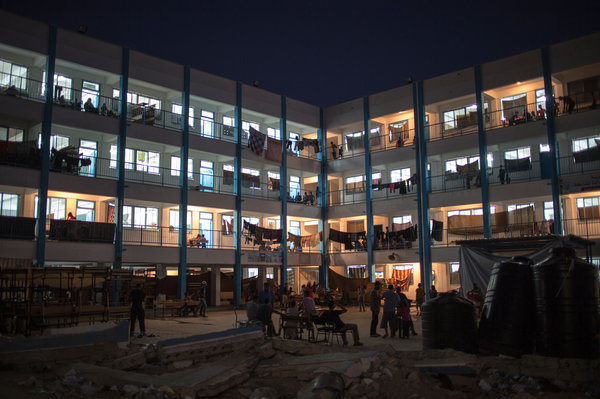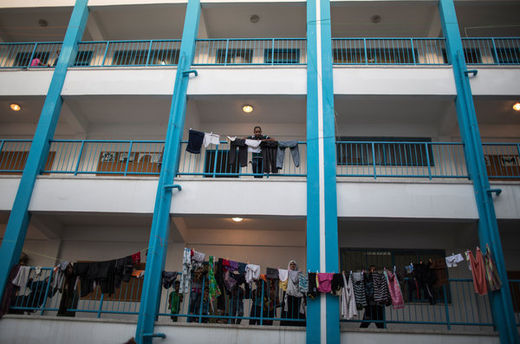There are 500,000 students who were scheduled to be divided among 648 schools, with 421 of the buildings being shared in double shifts. But the fighting between Israel and Hamas over the summer left at least 34 buildings damaged beyond use and dozens more in need of major repair. An additional 31 schools are still sheltering 59,728 residents who lost their homes.
Now, the students must be sorted into classrooms, taking into account that thousands no longer live where they did last year.
"This is the most challenging year for us," said Farid Abu Athra, the head of the education program for the United Nations Relief and Works Agency, which runs schools for half of Gaza's students. "We have a plan, but when we see facts, it might change. When our teachers face the students in the schools, I think we will know."
Getting students back to school is a critical component in any community's return to normalcy after a crisis, but parents and educators in Gaza know that it will be a relatively small salve on a gaping wound. Beyond the logistics of getting students back into the classroom, they face a far more consequential challenge: how to educate a generation that has survived three wars in six years, the latest killing 500 Gazans under 18 and injuring 3,100, as well as, according to one estimate, creating 1,400 orphans.
For the first few weeks, officials plan to set aside the curriculum in favor of games, sports, drama and other activities designed to deal with trauma. In an activity called "protected child," classmates encircle a student and ward off threats by someone outside; in another, children trace each other's bodies on mural paper and then mark the strong and weak points they felt during the war.
There is likely to be much movement in the first few months as displaced families shuttle among temporary homes. And what if the cease-fire agreed to last week does not hold?
"They must learn, but they are still confused because of the war; they are still afraid," said Zahra Hamad, 36, who has five children, including first and second graders at a Beit Hanoun school that was hit by deadly strikes on July 24, when it served as a shelter. "People were killed in this school, so the kids are afraid."
Comment: Children cannot learn or learn with great difficulty when they are still afraid.
Israel managed to open its public schools on time on Monday, but it also adjusted its programs. The focus in the first two weeks, the Education Ministry said in a news release, will be on "activities for relaxation and providing emotional support and personal strengthening," with students creating photo albums, discussing dreams and experiences, taking trips to national sites and planning talent shows. Racism and freedom of expression were among the planned topics, with one suggested exercise using examples of verbal abuse on social media during the summer's operation.
Comment: Are Israeli pupils learning how to feel and act like a victim? Who exactly are victims of racism, stifled freedom of expression and verbal abuse on social media here?
Schools closest to Gaza, where camps, beaches and pools were closed and children spent much of the summer inside bomb shelters amid barrages of rockets, have extra counselors on hand and plan therapy using crafts, drama, dance and music. Among the 72 Israelis killed in the war was a 4-year-old boy felled by a mortar shell on a kibbutz.
Comment: While children in Gaza have to work through their war traumas with paper and pencils Israeli pupils have access to counselling and therapy. What is wrong with this picture?
"This is a very small country, and everything is felt," Yochi Siman-Tov, the head of the Education Ministry's unit for coping with crisis, said in an interview. "We see schools as a place that can offer assistance and personal support, and we know the immediacy of providing emotional support can be critical for people's healing."
Comment: The lack of empathy for the children of Gaza and what they have to go through is mind-boggling.
In Gaza, the first order of business is for classrooms to be cleaned. At the Salah Eddin Prep Boys A & B school in Gaza City on Tuesday, the morning after the last of the 2,800 people who had sheltered at the school were moved elsewhere, a man with a green sponge wiped disinfectant on a doorway. He was part of a crew of 11 clearing trash, fixing toilets, replacing broken windows and repainting walls. A barefoot boy carried out a can of garbage.
Mr. Abu Athra, the United Nations' education chief in Gaza, said that more than 200 computers were stolen from at least 20 of his schools that were used as shelters. Desks and chairs also disappeared. By Tuesday, copies of only 89 of the 135 required textbooks had been printed, in a process that is normally completed by Aug. 1.
The United Nations is trying to consolidate about 50,000 people still in its shelters into 20 buildings, but some will not leave. In Beit Hanoun, the northern border town where whole neighborhoods were leveled, more than 1,000 people staged a sit-in on Saturday at Girls Preparatory A.
Mohamed Kafarna, a 30-year-old father of six, said he spent the war at a school in Jabaliya, and after the cease-fire he moved to Girls Prep, where he set up camp under a corrugated tin awning in a corner of the courtyard. Though the school lacks electricity, Mr. Kafarna connected plugs to a school next door to power a standing fan, a light and a cellphone charger inside the walls he put up, made of blankets and mats with a United Nations logo.
"We don't want to move from a school to another school," he said. "Let them find us something final. We are tired."
The United Nations Relief and Works Agency runs schools through ninth grade for the descendants of Palestinians who were expelled from or fled homes in Israel and the West Bank, about 70 percent of Gaza's 1.8 million residents. The rest, and all 10th, 11th and 12th graders, attend government schools.
Ziyad Thabet, Gaza's deputy education minister, said government schools suffered $13 million in damage to buildings and $6 million to furniture. He estimated costs of $3 million to provide special services to injured children, including distance learning for those in hospitals and wheelchairs for those who cannot walk. Mr. Thabet said classes were likely to average 40 or 41 students this year, up from 36 last year.
"We consider our success and our victory is to start the school year," he said. "Our message to students," he added, "is they must work hard despite the hard circumstances in order to make their future better than the future of their fathers and teachers."
Comment: What these young people need is empathy, time and patience. They are victims of war. They have lost members of their family. They have witnessed atrocities that no child should ever witness. How can one function when the future is absolutely uncertain for these children and their families?
One principal, four teachers and two guards at United Nations schools were killed, along with 22 employees of the government's Education Ministry, during the fighting. Many more are among the estimated 100,000 Gazans who lost homes. The teachers start work on Sunday, for a week that will include training in the trauma activities.
Akram Nasser, a teacher of ninth-grade Arabic who spent the summer running shelters, said arriving students would need a lot of support. "I know some of them have lost a father or a sibling," Mr. Nasser said. "I'll try to comfort them. I'll be as a father, as a brother for them."
Fares Akram contributed reporting from Gaza, and Irit Pazner Garshowitz from Jerusalem.





Reader Comments
to our Newsletter